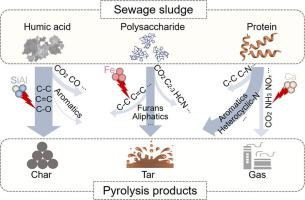Chemical Engineering Journal ( IF 13.3 ) Pub Date : 2022-04-27 , DOI: 10.1016/j.cej.2022.136627 Zhihang Yuan 1 , Zhongyue Zhou 2 , Jinming Luo 1 , Haiping Yuan 1, 3 , Nanwen Zhu 1, 3 , Ziyang Lou 1, 3, 4

|
The composition of sewage sludge is complex, and understanding the product contribution and pyrolysis pathways of typical components in sludge are important for product quality improvement and contaminant volatiles control. Here, three major sludge organics, i.e., protein (PR), polysaccharide (PS), and humic acid (HA), were extracted and pyrolyzed individually to quantify the correlation between sludge components and products. The temperature-response and sludge inorganics-response of pyrolysis processes were elucidated simultaneously. The main contributor to the carbonaceous components in char shifted from PR (from 51% to 7%) to HA (from 27% to 78%) as temperature increased from 250℃ to 850℃. Over 95% tar and 70% gas were originated from PR and PS at temperature above 550℃. Regarding the effect of inorganic matters, Ca/Si/Al-containing inorganics were the major inducement for the formation of nitrogenous tars and NOx, whereas polyferric chloride retained sludge organics in the carbon matrix in the form of C–C/C = C and heterocyclic-N/S, thus reducing the generation of volatiles. Based on pyrolysis product evolution and elemental flow analysis, sludge rich in HA and low in Ca/Si/Al-containing inorganics was found to be a promising source for carbonization at 550-850℃, while PR/PS-rich sludge was more suitable for pyrolysis or liquefaction at below 550℃. These findings provided reliable strategies for pyrolysis precursor selection, gas emission control, and potential application of pyrolysis product.
中文翻译:

量化热解过程中污泥絮体中可溶性有机物的热化学途径,以优化前体和副产物控制
污泥成分复杂,了解污泥中典型成分的产物贡献和热解途径对于提高产物质量和控制污染物挥发物具有重要意义。在这里,三种主要的污泥有机物,即蛋白质(PR)、多糖(PS)和腐殖酸(HA),被分别提取和热解以量化污泥成分和产物之间的相关性。同时阐明了热解过程的温度响应和污泥无机物响应。随着温度从 250℃ 升高到 850℃,炭中碳质组分的主要贡献者从 PR(从 51% 到 7%)转变为 HA(从 27% 到 78%)。超过 95% 的焦油和 70% 的气体来自 PR 和 PS,温度高于 550℃。关于无机物的作用,x,而聚合氯化铁以 C-C/C = C 和杂环-N/S 的形式将污泥有机物保留在碳基质中,从而减少了挥发物的产生。基于热解产物演化和元素流分析,发现富含 HA 和低 Ca/Si/Al 无机物的污泥在 550-850℃ 是碳化的有希望的来源,而富含 PR/PS 的污泥更适合在550℃以下进行热解或液化。这些发现为热解前体的选择、气体排放控制和热解产物的潜在应用提供了可靠的策略。











































 京公网安备 11010802027423号
京公网安备 11010802027423号